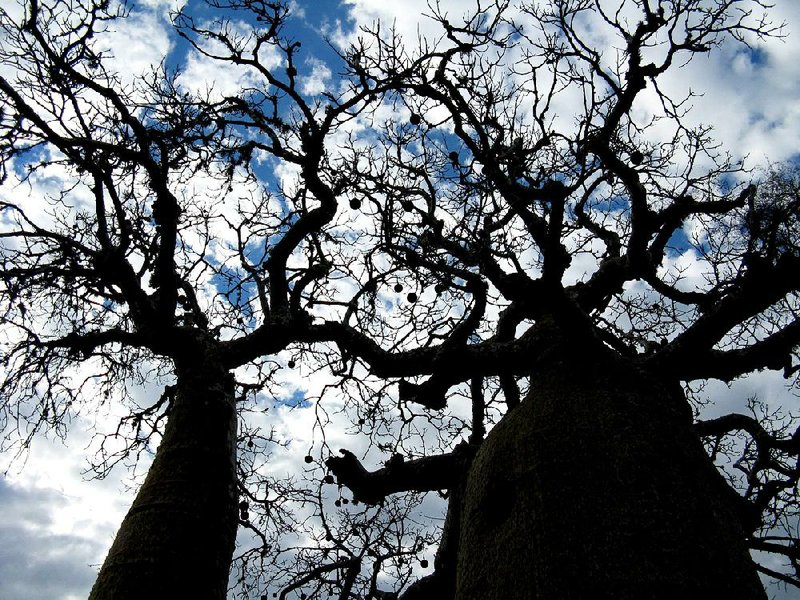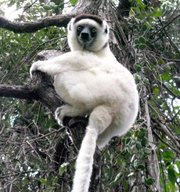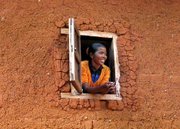A biologist by training, I ask a lot of questions -- so many that I've been compared to Frank Columbo, the 1970s TV detective whose tag line was, "Just one more thing ..." My inquisitiveness, however, focuses on understanding the curious attributes and adaptations of plants and animals.
Questions at the ready, I signed up with Exodus Travels to cycle and trek in Madagascar. The world's fourth-largest island sits off the east coast of Africa, a location it has occupied for more than 100 million years. For biologists, it's an Eden. Considered to be a mega-diverse country -- one of 17 in the world -- the island is home to substantial numbers of flora and fauna found nowhere else in the world.
WHERE TO STAY
Hotel Au Bois Vert
Ivato 101, Antananarivo
Simply furnished cottages with interiors embellished with Malagasy symbols (zebu, palms and wagons) dot a lush landscape within this expansive gated property. Rooms from about $99, with breakfast included.
Hotel Plumeria — Antsirabe
Lot 0912 C 90 Manodidina NY Gara, Antsirabe
In the center of a bustling town that’s almost 5,000 feet above sea level, this contemporary boutique property is a placid retreat. Rooms from about $52.
Dine alfresco at their restaurant on specialties that include zebu carpaccio or stew. Main courses from about $5.
Hotel de la Plage
BP 397 — 601 Tulear 1, Ifaty
Simple bungalows, each with a deck — and where it’s literally lights out at 11 p.m. — are set along the beachfront. Rooms from about $45. Its restaurant also features fish sourced from area fisherman. Have a meal on the breezy terrace or small gazebo for a more private setting. Main courses from about $6.
What to do
Exodus Travels
(844) 227-9087
Among the company’s Madagascar trips are those that involve cycling, trekking and/or bus. Tours run from May to October. Prices, which include lodging, ground transportation, van support, bicycles, guides and breakfast, start at $3,295. Guests arrange their flights to Antananarivo. Keep in mind that cycling and trekking tours are moderate to challenging.
Information
I shared the two-week adventure and covered more than 300 miles with a group of 13 other vacationers. They included a married couple who regularly cycled in the perfectly level Netherlands where they lived; a young Australian woman and her boyfriend, who both were novice cyclists; and an older Englishman who admitted that he had prepped for the trip with weekend pub rides. As for me, I've biked all over the world -- including carrying my own gear for long distances over difficult terrain -- but I'm not into speed.
It soon became apparent that Madagascar was my kind of place. Our Malagasy guide, Andriniaina "Mel" Armel, explained the island's philosophy on the first day. "You'll hear people say 'mora,' which means 'slowly, slowly,'" she said. "They'll say it when they see you cycling, they'll welcome you with 'Bonjour, mora' -- whatever it is, you'll hear 'mora.'"
Once we were on the gently undulating road, I settled into a laid-back rhythm, stopping often to take notes, peruse my naturalist books and snap photos of the wildflowers and other flora that lined the road. The arid landscape was blanketed with brick-red soil; we cycled past rice paddies and two-story adobe dwellings toward a horizon dominated by rounded mountains.
To my surprise, the rest of the group took off pedaling like it was the Tour de France -- a pace they also kept during our hikes -- and within moments they were so far ahead that their colorful bike jerseys were mere orange, yellow, blue and red dots cresting the hills.
On the descents and straightaways, their courage was on full display as they tackled hairpin turns at high speeds, deftly negotiating the deep potholes and other obstacles dotting our path. These ranged from motorbikes and minivans to wheeled carts, chickens and people carrying firewood or walking to market while balancing their wares on their heads. I hung back, most memorably when we cycled through a herd of zebu, an ancient breed of humped, horned cattle revered by locals.
After observing my relaxed pace, Mel assigned a junior guide or the bike mechanic to cycle with me at the rear. On hikes, Mel also divided us by speed -- I was the only one in the "snail" group, which left me with my own guide, perfect for my inquisitive nature. Our southwestern route from the middle of the country and the capital, Antananarivo, to coastal Ifaty allowed me to study the full breadth of Madagascar's landscapes and inhabitants.
. . .
The scenery changed dramatically once the road meandered into Ranomafana National Park, an almost 100,000-acre UNESCO World Heritage site where more than 90 percent of the plant species are endemic.
With my group far ahead, I relished cruising down steep switchbacks at a speed that allowed me to enjoy the sun-dappled terrain, fresh-smelling air and dramatically cooler temperatures, thanks to the thick cover of tree ferns, symphonia trees, wild ginger and other plant life brimming around me. I gawked at the gushing waters tumbling down a ravine into the Namorona River.
The next morning, after we donned hiking boots, Mel matched me with guide Rajeriarison Emile. "They call him 'frogman' because he discovered a species of frog -- Anodonthyla emiliei," she explained. When I told him I was a biologist, he smiled with delight. So did I. He was Ranomafana's first guide when it became a national park in 1991, and his knowledge was expansive.
As he led me down a track dense with bamboo and banana, fig and avocado trees, my vision was suffused with vibrant greens. Luckily, the eagle-eyed guide pointed out a baby peacock-green gecko clinging to a branch, and then tiny pink orchids hanging on a tree trunk. At our feet sprouted stink mushrooms, so named because their musky odor attracts insects that spread the spores. "You can smell many things in the forest; even the glands of each lemur species give off a different scent," Rajeriarison noted.
All around us were soaring, gargantuan ferns. "These fern trees take 100 years to grow this big," he said. Then he asked where I thought the park's vegetarian lemurs -- it's home to 12 species -- get their protein. "Each fig species has a specific wasp type that pollinates the flower inside the fruit," he said. "The lemur eats the fruit, getting their protein from the wasp inside."
In our hunt for lemurs, he took me down a narrow, muddy, root-and-rock-laden trail that descended steeply through thickets. Our search was rewarded when, above our heads, a golden bamboo lemur jumped between tree limbs. "They eat the shoots of bamboo," said Rajeriarison, who explained that although the shoots contain cyanide, the lemurs also eat clay, which neutralizes the poison.
A piercing sound echoed through the forest. "That's the call of the female red-bellied lemur," he said. "They use it when they're lost."
. . .
Cycling through Madagascar's vast savanna, with its pervasive tall grasses and impressive granite buttes, I felt very small. The feeling persisted the following day as we trekked through Isalo National Park, a canyon land of wind-and-water-eroded sandstone gorges and rock towers. My assigned guide, Jules Ravelomanantsoa, who lived nearby and had been leading hikes here for 20 years, was happy to answer my incessant questions as we wandered through the Canyon des Makis, where the red-hued cliffs are honeycombed with caves that serve as temporary burial chambers for the Bara tribe.
My attention was immediately drawn to a tree bearing clusters of lime-green oval fruit.
"The fruit of this sakoa tree tastes like a sour mango," Jules explained. "The bark can be used to make a tea for stomach problems." I passed up the chance to sample it, and we proceeded along a narrow, sandy trail that snaked through a sandstone-laden landscape whose contorted rock formations resembled a tortoise, a crocodile and other creatures.
I continued to lag far behind the rest of my group. As Jules and I reached an expansive, grassy plateau dotted with sandstone massifs, a sense of isolation and utter silence prevailed. I settled into a meditative reverie and dropped the Columbo routine. That is, until Jules stopped to point out some low-lying plants with ruby-red, hairlike structures. "It's carnivorous, but you can boil it for throat problems," he said.
Life was all around us, I realized, despite the seemingly arid landscape. To underscore the point, several ring-tailed lemurs scampered down the cliffs from their home high in the caves, much to my delight.
. . .
I became fascinated with the country's oddly shaped baobab trees as I was cruising along its southwest coast. Endemic shrubs, brush and trees, adapted to the drought-prone environment, have populated the spiny forests -- as one of the island's unique ecoregions is known. Madagascar's national tree -- the baobab -- stands sentinel with a swollen trunk and finger-like branches that appear to reach for the sun.
The next day in Ifaty -- a designated rest day when most of my group cycled, snorkeled or relaxed at our seafront accommodation -- I booked a trek through nearby Parc Mosa to learn more about the quirky trees. As we strolled along flat trails thick with red sand, my amiable guide, Clovis Ratsaranandrasana, told me of his previous life. "I used to work in the sapphire mines," he said as butterflies flitted about. "It was very hard work that was very dangerous -- I'm very happy to be working here."
We stood beside a cluster of soaring baobabs. "They grow slowly, one millimeter a month," Clovis said. He pointed out indentations that locals had cut into two of the trees as footholds to reach the fruit -- they make a sour-tasting juice from the small, coconut-shaped fruits. The oil is said to have anti-aging properties, and Malagasy women crush the seeds to make face cream.
"Before these trees were protected here, people would also cut them for water and to make rope from the fibrous bark," Clovis explained.
He led me from a short, skinny baobab sapling that is only 10 years old to the park's oldest (1,400-year-old) specimen. I embraced its 40-foot-circumference trunk. "Thanks for sharing this park's treasures with me. And sorry for all my questions," I said.
My guide's reply: "Never too many questions."
Travel on 07/01/2018



